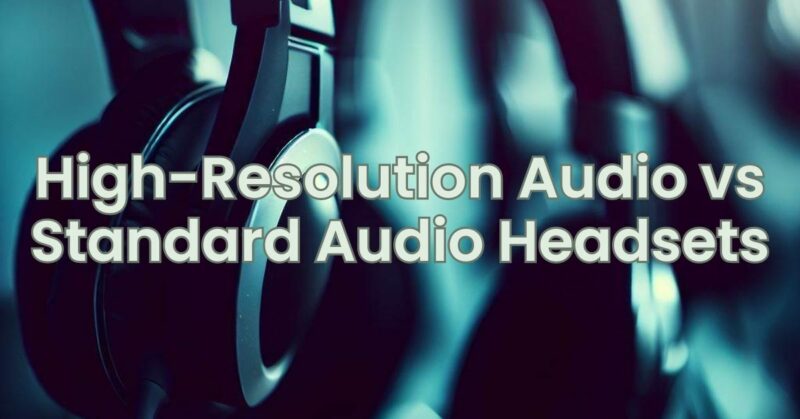When it comes to choosing a headset, audio quality is a critical factor. High-resolution audio and standard audio are two terms often used to describe audio quality, but what sets them apart? In this article, we will explore the differences between high-resolution audio and standard audio headsets, helping you understand the benefits and considerations of each option.
- Standard Audio Headsets
- Audio quality: Standard audio headsets typically offer audio quality that is suitable for everyday listening. They provide a good balance between sound reproduction and affordability. However, the audio may not capture the full range of detail and nuance found in high-resolution audio formats.
- Audio formats: Standard audio headsets are designed to support common audio formats such as MP3, AAC, and WMA. These formats compress audio files, reducing file size but also sacrificing some level of audio quality.
- Frequency response: Standard audio headsets generally have a frequency response range of 20 Hz to 20 kHz, covering the audible range of human hearing. This range is sufficient for most music genres and everyday listening needs.
- Source material: Standard audio headsets are well-suited for listening to standard audio sources such as streaming services, digital downloads, and CDs. They may not fully exploit the benefits of high-resolution audio formats.
- High-Resolution Audio Headsets
- Enhanced audio quality: High-resolution audio headsets are designed to deliver superior audio fidelity and capture more detail and nuance in the sound. They reproduce audio with greater precision, offering a more immersive and lifelike listening experience.
- Audio formats: High-resolution audio headsets support lossless audio formats such as FLAC (Free Lossless Audio Codec) and ALAC (Apple Lossless Audio Codec). These formats preserve the original audio quality without significant compression, allowing for a more accurate representation of the recording.
- Extended frequency response: High-resolution audio headsets typically have a wider frequency response range, often extending beyond the range of standard audio headsets. This wider range can reproduce frequencies that are beyond the threshold of human hearing, resulting in a more detailed and dynamic audio experience.
- Source material: High-resolution audio headsets are best paired with high-resolution audio sources, such as high-quality digital files or lossless audio streaming services. These sources offer audio recordings with greater detail and resolution, maximizing the benefits of high-resolution audio headsets.
- Considerations for Both
- Source material availability: High-resolution audio files are typically larger in size, requiring more storage space and higher bandwidth for streaming. Ensure that you have access to high-resolution audio sources that match your preferences and listening habits.
- Audio source compatibility: Check the compatibility of your audio sources with high-resolution audio headsets. Some devices or platforms may have limitations on the audio formats they support, which can affect the audio quality experienced through the headset.
- Personal preference: Ultimately, the choice between high-resolution audio and standard audio headsets depends on your personal preferences and the level of audio quality you desire. Consider your listening habits, the availability of high-resolution audio content, and your budget when making a decision.
Here is a table summarizing the differences between high-resolution audio and standard audio:
| Feature | High-Resolution Audio | Standard Audio |
|---|---|---|
| Sample rate | 96 kHz or 192 kHz | 44.1 kHz |
| Bit depth | 24 bits or 32 bits | 16 bits |
| Detail and clarity | More detailed and clear | Less detailed and clear |
| Price | More expensive | Less expensive |
High-resolution audio headsets offer superior audio quality, capturing more detail and nuance in the sound compared to standard audio headsets. They are designed to deliver a more immersive and lifelike listening experience, particularly when paired with high-resolution audio sources. However, standard audio headsets are suitable for everyday listening needs and offer a good balance between affordability and sound reproduction. Consider your preferences, audio sources, and budget to determine whether a high-resolution audio headset is the right choice for you.


